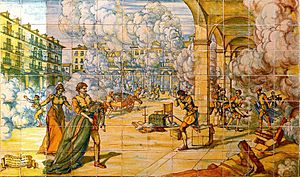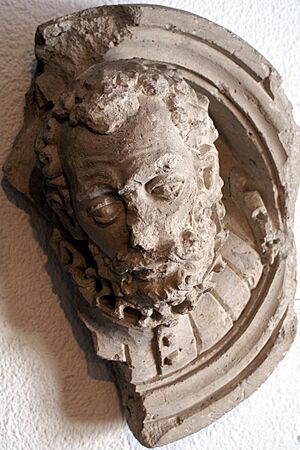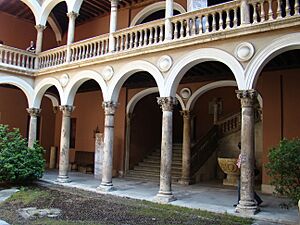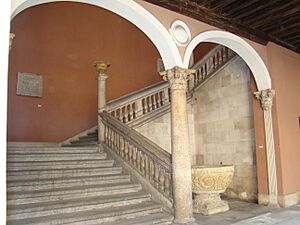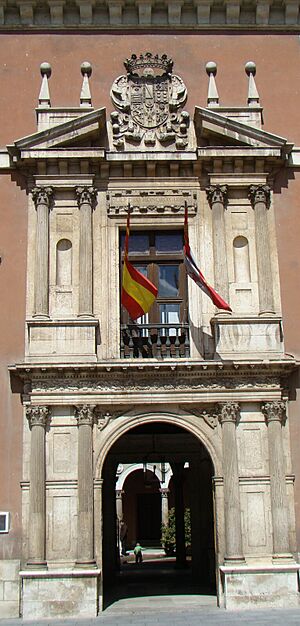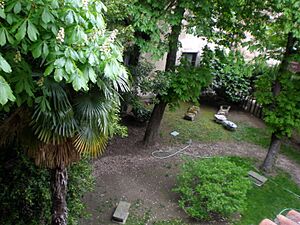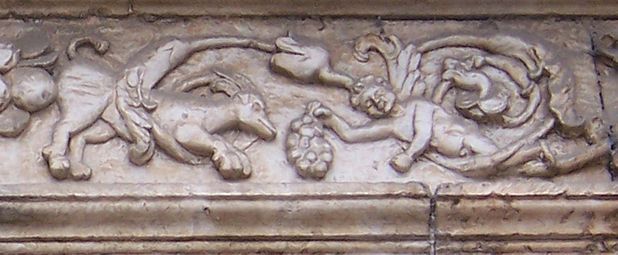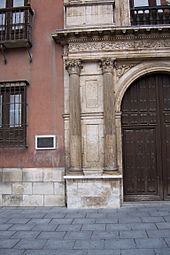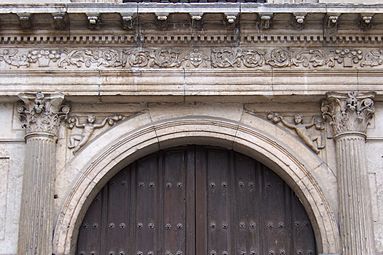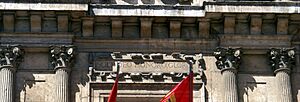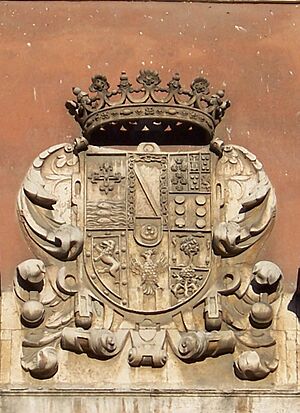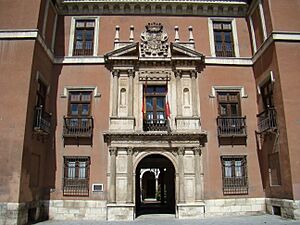Palacio de Fabio Nelli facts for kids
The Palacio de Fabio Nelli is a very important Renaissance building in Valladolid (Castile and León, Spain). Experts say it's the best example of its kind in the city. It was built during a time when Valladolid was becoming less important. The construction took about 20 years, with some breaks and a change of architect after the first one passed away.
The palace is designed in the classic Italian style. Its front, courtyard, and stairs are great examples of this type of architecture in Valladolid. After the banker Fabio Nelli died, the palace was used for different things. In the 20th century, it became the home of the Valladolid Museum. This museum collects old items and artworks from the area. The building is still in good shape, but it needs some cleaning and repairs. The museum also hopes to expand its space.
Contents
Valladolid's Past: A City's Ups and Downs
In the mid-1500s and early 1600s, Valladolid was a city that saw both great times and tough times. Fabio Nelli was born in 1533. Around this time, the city had slowed down after a big defeat called the Revolt of the Comuneros.
In 1527, a very important event happened in Valladolid: the future king, Felipe II, was born there. That same year, work began on a new church, which later became the cathedral. However, it was never fully finished.
In 1561, a huge fire destroyed a large part of the city. King Felipe II promised to rebuild the damaged areas. He gave the city Spain's first regular main square. But then, the king decided to move his royal court to Madrid. This was a big problem for Valladolid, and the city became much less important for a long time.
Valladolid got a small boost in 1601 when the court returned for five years. But in 1606, Felipe III moved it back to Madrid. Valladolid then went into a long period of quiet until the 1800s.
Who Was Fabio Nelli?
Fabio Nelli was an important banker from Valladolid, born in 1533. His father, Alfonso Nelli, was from a banking family in Siena (Italy). Sadly, his father died without much money. After his father's death, Fabio Nelli left Seville with his aunt and uncle. He spent most of his working life there.
Fabio Nelli married Violante Rivadeneira, and they had two daughters: Damiana and Leonor. Damiana had a son named Alonso Nelli. Alonso's son, Baltasar Francisco de Rivadeneira y Zúñiga, was given the title of Marquis in 1663 by King Felipe IV. You can still see his family's shield on the front of the Fabio Nelli palace today.
In 1595, Fabio Nelli set up a special family inheritance system called a mayorazgo. This meant his property would pass down to his eldest daughter, Damiana, and her children.
Building the Palace: From Idea to Reality
Valladolid was a busy trading city, attracting rich merchants and bankers. Fabio Nelli, whose family had strong business ties with the Crown, was born in Valladolid. But his family's work took him away from his hometown. He finally returned for good in 1576. That's when he decided to build his grand home.
He bought several houses from the Earl of Osorno. The first architect, Juan de la Lastra, started designing a Spanish-style residence. The work began in 1576. Juan de la Lastra and Fabio Nelli signed an agreement for the building's foundations. The plans were very detailed, including measurements and materials.
Juan de la Lastra built the foundations and early parts. His design was typical for Valladolid palaces. It had a hallway on the left side of the front. The street door and the courtyard door were not lined up. This made it hard to see into the courtyard from the street. He used ideas from the Italian architect Baldassare Peruzzi for the courtyard door.
However, Juan de la Lastra became ill and died in 1582. After his death, the sculptor Francisco de la Maza and the architect Pedro de Mazuecos El Mozo took over. They started working on the courtyard and stairs, following Mazuecos's designs. These works were finished in just four months.
In 1589, Fabio Nelli decided to manage the building work himself. He wanted the palace to follow the latest Italian styles. He trusted Pedro de Mazuecos El Mozo completely. Mazuecos brought in new ideas from Italy, especially from the writings of Sebastián Serlio. These ideas focused on balance and having a central point.
Mazuecos changed the palace's entrance. He moved the courtyard door from the left corner to the very center. He also made sure the street entrance was in the middle of the front. This created a sense of balance and order. This new design brought classic Italian ideas like symmetry and a central focus to Valladolid's palace architecture.
What the Palace Looks Like
The front of the palace has a central part and two towers on the sides that stick out a bit. The bottom part is made of stone, and the walls are brick. Most of it is covered in plaster, except for the main entrance.
The main door is rounded, with double columns on each side. Above the door, there's a decorated strip with small angels and plants.
Above the door, on the second level, there's a balcony with a bronze railing. On the stone above the balcony, you can read the words "Soli deo honor and glory." There are also more double columns, with small decorated spaces between them. The very top part is broken in the middle, and that's where the family shield is placed. The top is finished with pyramids and balls, a style popular at the time.
The side of the palace you can see today faces what was once "Bridge Street." This side has a gallery of arches decorated with interesting faces, showing Italian influence. The other side of the palace is hidden by other buildings. Part of this hidden side faces the palace garden, called "the vergel."
The main entrance door is in the center. It leads to a hallway, and the door from the hallway to the courtyard is also centered and lines up with the street entrance.
Decorations and Their Meanings
The palace has many interesting decorations. For example, you can see images of Bacchus, the god of wine, calming wild animals with wine.
There are also small, playful figures, like little angels, holding a round medal or shield. These were common in Spanish Renaissance art.
You'll find baskets full of fruit on the tops of the columns. This represents plenty and good fortune. It was a popular symbol in Valladolid palaces in the 1500s.
In the middle of the decorated strip above the door, there's a face with a sarcastic, almost devilish look. This figure might remind you of Italian satyrs or a scary mask. Some people think it represents an inner light or a window.
On the curved parts of the entrance arch, there are two small figures of children holding fruits. Some believe these figures represent love.
The Motto on the Frieze
The words on the frieze usually mean "Only to God honor and glory." But it's unusual to see this phrase on a regular building, not a church. Some people think it might have been a praise to King Felipe II, who was sometimes called the "Sun-King." In that case, it would mean "To the sun-god honor and glory." This could have been Fabio Nelli's way of thanking the king for giving him a special title.
The Family Shield
The shield you see on the palace today belongs to Fabio Nelli's grandson, Baltasar de Rivadeneira y Zúñiga. This same shield is also found in the village of Boecillo, which was once Fabio Nelli's country home. However, the original shield on the palace belonged to Fabio Nelli himself. We know this from descriptions written in 1608.
Fabio Nelli was proud of his family's history. His ancestors had been favored by Emperor Charles V. The Emperor allowed them to include half of the imperial eagle in their family shield.
Tile Decorations
When the palace was built, Valladolid had excellent workshops for making tiles. In 1586, a workshop opened that created the tile decorations for Fabio Nelli's palace. They often used images from myths and stories. You could also see knights in walled cities, following the popular Italian Renaissance style. Besides these scenes, the pomegranate fruit was often used as a decoration. It was a symbol of royalty, and its bittersweet taste was compared to the good and bad parts of ruling.
The Palace After Fabio Nelli
Fabio Nelli wanted the palace to be used for good causes after he died. He wrote that it should become a hospital and a place for poor students to stay. However, this never happened. At first, it was home to important religious leaders and was also rented out to private people.
In 1774, a group of friars from a nearby convent became the managers of Fabio Nelli's properties. At that time, a man named Ramon Castaños Leguizamon was renting the palace. He paid for repairs to the building. The friars complained about this, but a court ruled that Mr. Castaños was right.
During the War of Spanish Independence, French soldiers used the palace as a warehouse, causing a lot of damage. In 1816, it became offices for the Royal Tax Department. Later, after some government changes, it was sold to a private owner.
In the 20th century, the government bought it back. In 1968, it was restored to become the Archaeological Museum. Today, it is known as the Valladolid Museum.
The Palace Today
The Fabio Nelli palace has been a museum and a protected cultural site since 1961. The government is responsible for its upkeep. The palace hasn't been fully restored since 1968. After more than 40 years, the museum managers believe the front and courtyard need cleaning.
This palace is very important to Valladolid and the region. It's a perfect example of a classic Valladolid palace, especially its Renaissance front and courtyard. A special feature of Valladolid palaces is that the north-facing side of the courtyard is often a solid wall, without arches. This helps protect against the cold winds of the city and allows the courtyard to get more sun. While other palaces in the city have similar features, the Fabio Nelli palace stands out for its grandeur.
Future Plans for the Museum
The Valladolid Museum wants to expand. In 2003, they presented a plan to the city council to build an addition behind the palace. This area is part of the city's historic district. Some neighbors who live near the palace complained to the court. They felt the project didn't follow the city's building rules. The court sided with the neighbors, so the expansion project is currently stopped.
The museum managers say that more space is urgently needed. The palace's basements are full of archaeological finds from the entire province. There's even another storage area in an industrial zone. Besides needing more space for artifacts, the expansion project also included a thorough cleaning and repainting of the palace. This would help restore its original look.
About the Museum
The museum started in 1879 as the Provincial Museum of Antiquities. It was first located in the Santa Cruz School. The museum's collection is divided into two main parts: Archaeology (10 rooms) and Fine Arts (8 rooms).
The Archaeology section shows a complete timeline of items found in Valladolid province. These range from the Stone Age all the way to the Middle Ages. The Fine Arts section displays paintings from the 1400s and 1500s, tapestries from Flanders, silver and gold items from the 1600s, Spanish pottery, sculptures, and a small section about the city's history.
Some important artworks in the Fine Arts collection include a painting of the Virgin Mary and the Child with two people giving gifts, and "The Adoration of the Shepherds" by Vicente Masip.
Among the archaeological items, a special highlight is the sarcophagus (stone coffin) of the child Alfonso of Castile, complete with his clothes and fabrics.
See also
 In Spanish: Palacio de Fabio Nelli para niños
In Spanish: Palacio de Fabio Nelli para niños


